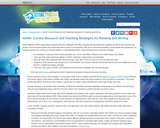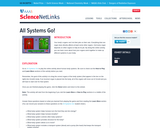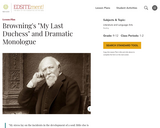
This resource is to help students learn how to sequence events in story.
- Subject:
- Reading Foundation Skills
- Material Type:
- Activity/Lab
- Author:
- MEGHAN PENNY
- Carrie Robledo
- Date Added:
- 03/25/2022

This resource is to help students learn how to sequence events in story.

Students will be reading historical fiction book at their own level. They will read, summarize, and create three book projects that correlate with some of the 4th grade common core reading standards.

This unit is focused on figurative language, covering common core standards in language, literature for reading, and speaking and listening with the final assessment. It is designed to be used with a workshop model, where there is some form of opening for brief instruction, partner and/or independent work time, and a closing time for sharing within each lesson.

This article provides an overview of current research about attention deficit hyperactivity disorder as well as strategies to help students with ADHD with reading and writing.

An online activity about human body systems. The goal of this activity is to drag the correct organs of the body system into Arnold's body. When you mouse-over an organ, its name appears. There is also a student sheet for students to answer questions based on the activity. This resource supports the English language development of English language learners.

This lesson introduces students to American colonial life and has them compare the daily life and culture of two different colonies in the late 1700s. Students study artifacts of the thirteen original British colonies and write letters between fictitious cousins in Massachusetts and Delaware.

This lesson concentrates on Anne Frank as a writer. After a look at Anne Frank the adolescent, and a consideration of how the experiences of growing up shaped her composition of the Diary, students explore some of the writing techniques Anne invented for herself and practice those techniques with material drawn from their own lives.

This article includes links to expository text for students in grades K-1, 2-3, and 4-5 about the climate differences between the Arctic and Antarctica.

This article assembles free resources from the Arctic and Antarctic Birds issue of the Beyond Penguins and Polar Bears cyberzine into a unit outline based on the 5E learning cycle framework. Outlines are provided for Grades K-2 and 3-5.

This article reprints and links to informational text about the adaptations that allow mammals and fish to survive in polar oceans. Versions are available for students in grades K-1, 2-3 and 4-5. Related science and literacy activities are included.

This article includes links to expository text for students in grades K-1, 2-3, and 4-5 about the aurora.

Understanding the Patriot attitude toward the British monarchy is helpful in understanding the Founders' reluctance to have a strong executive under the Articles of Confederation as well as their desire to build in checks of executive power under the Constitution.

In this lesson, students will listen to or read about bakeries in Mexico, types of pastries and bread baked daily. There are short and long passages with audio, scripts in Spanish and scripts in English. Short passages have about 125 words while long passages about 375 words. Included are comprehension questions and related links.

Learn about the checks and balances system of the three branches of the U.S. government.

In this lesson students learn how Birth of a Nation reflected and influenced racial attitudes, and they analyze and evaluate the efforts of the NAACP to prohibit showing of the film.

In this lesson, students create an oral presentation that uses a visual aid to sell their books to their classmates with the goal of trying to get their classmates interested in reading the book.

This session will bring new, integrated ideas and technology know-how to the K-5 teachers. Our goal for the session is to engage students, teachers, and parents, to share sample lessons, substantial amounts of free resources, and ways to integrate tech.
Link to presentation slides:
bit.ly/Literacy2Life

Reading Robert Browning's poem "My Last Duchess," students will explore the use of dramatic monologue as a poetic form, where the speaker often reveals far more than intended.

In this lesson from Expeditionary Learning, students will imagine themselves in the role of the main characters of That Book Woman by Heather Henson. They will discover the motivations of the characters through role-playing and investigating the illustrations in the text. Students will use an informational text to investigate why it might be difficult to get books to people, as it was in That Book Woman. This is Lesson 1 of 17 from the Grade 3 Curriculum Map Unit 3, Module 1: http://engageny.org/resource/grade-3-ela-module-1-unit-3 .

This lesson highlights the changing relationship between the city center and the suburb in the postwar decades, especially in the 1950s. Students will look at the legislation leading up to and including the Federal Highway Act of 1956. They will also examine documents about the history of Levittown, the most famous and most important of the postwar suburban planned developments.